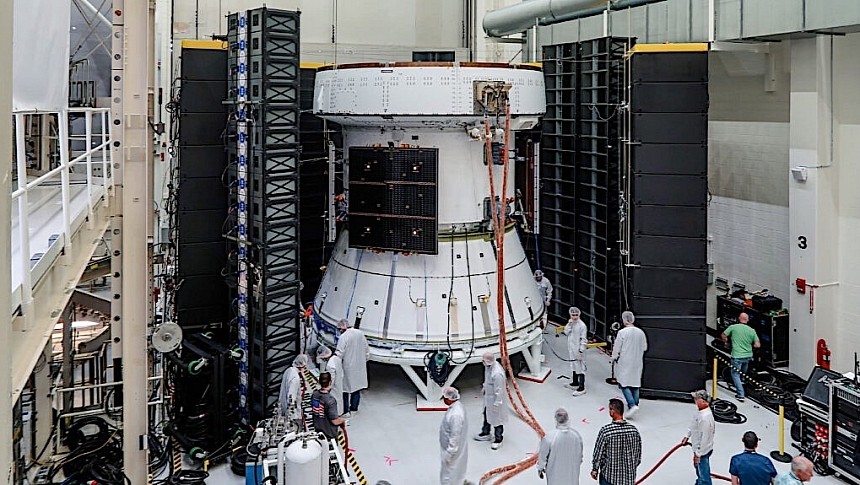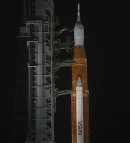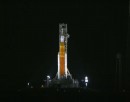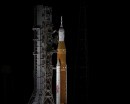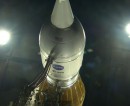Space exploration is a fascinating human activity, but at times it does come across as strange. Like when NASA rocket scientists surrounded the Artemis II Service Module with huge speakers and blasted sound at the thing.
The European Service Module by its full name is a part of the Orion spacecraft that will take the first crew of astronauts on a trip around the Moon as part of the Artemis program. It's a 4-meter (13 feet) unpressurized piece of equipment that holds the main engine of the spaceship and some fuel.
It's this module that supplies the astronauts on board with electricity, water, and oxygen, so it's basically an item the mission will not be possible without. That's why making sure it survives the harsh conditions at launch and beyond is crucial. And that's where said speakers come in.
You see, during launch of the Orion by means of the Space Launch System (SLS), the entire ship, Service Module included, is subjected to high speeds and vibration. The only way to replicate that here on Earth is to create sound waves that can have a similar effect on the pieces of hardware.
Sometime in the recent past, at the Kennedy Space Center in Florida, the European Service module went through exactly such a series of trials and tribulations. They are officially called acoustic tests, and required huge speakers blasting sound at it from very close, while microphones and accelerometers recorded what happened.
The data gathered this way is now being analyzed to see how the module performed. If everything checks out, the module will move to be integrated with the Orion Crew Module by the end of this year.
The Artemis II mission is tentatively scheduled for liftoff in November next year. The mission will be the first crewed one of the program, and will be flown by four people: Christina Koch, Reid Wiseman, Victor Glover, and Jeremy Hansen.
Although it will not land these four on the Moon, and only travel around it, the mission will have a series of first. The most important is that these people will become the ones to travel farthest from Earth yet, moving at some 6,400 miles (10,300 km) beyond the Moon.
The mission will last for a total of ten days and will take the crew on a figure eight trajectory that spreads to a total of 230,000 miles (370,000 km) from the surface of the planet they departed from. The trajectory was chosen like this for the spaceship to be able to take advantage of the gravity field between our planet and the Moon and save fuel.
If successful, Artemis II will open the doors to the actual landing mission, which will hopefully take place before this decade is over.
It's this module that supplies the astronauts on board with electricity, water, and oxygen, so it's basically an item the mission will not be possible without. That's why making sure it survives the harsh conditions at launch and beyond is crucial. And that's where said speakers come in.
You see, during launch of the Orion by means of the Space Launch System (SLS), the entire ship, Service Module included, is subjected to high speeds and vibration. The only way to replicate that here on Earth is to create sound waves that can have a similar effect on the pieces of hardware.
Sometime in the recent past, at the Kennedy Space Center in Florida, the European Service module went through exactly such a series of trials and tribulations. They are officially called acoustic tests, and required huge speakers blasting sound at it from very close, while microphones and accelerometers recorded what happened.
The data gathered this way is now being analyzed to see how the module performed. If everything checks out, the module will move to be integrated with the Orion Crew Module by the end of this year.
The Artemis II mission is tentatively scheduled for liftoff in November next year. The mission will be the first crewed one of the program, and will be flown by four people: Christina Koch, Reid Wiseman, Victor Glover, and Jeremy Hansen.
Although it will not land these four on the Moon, and only travel around it, the mission will have a series of first. The most important is that these people will become the ones to travel farthest from Earth yet, moving at some 6,400 miles (10,300 km) beyond the Moon.
The mission will last for a total of ten days and will take the crew on a figure eight trajectory that spreads to a total of 230,000 miles (370,000 km) from the surface of the planet they departed from. The trajectory was chosen like this for the spaceship to be able to take advantage of the gravity field between our planet and the Moon and save fuel.
If successful, Artemis II will open the doors to the actual landing mission, which will hopefully take place before this decade is over.
